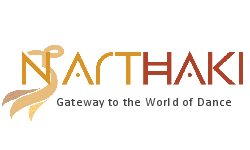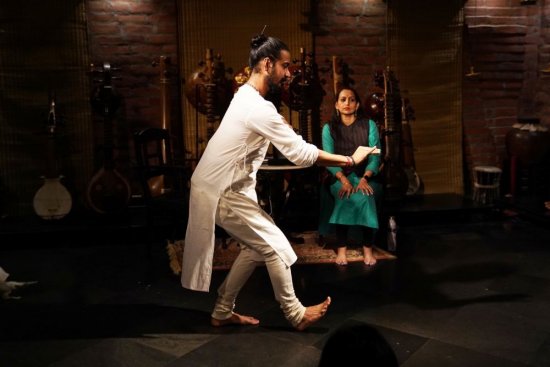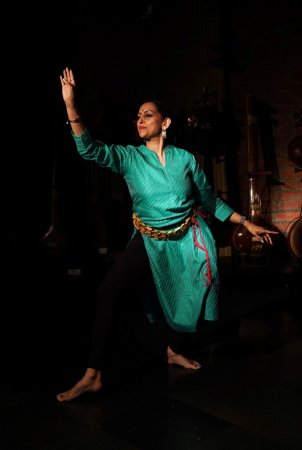
|   |

|   |
Rooted in Flow - Tapati Chowdhurie e-mail: tapatichow@yahoo.co.in Photos: Amarendra Nath Dutta May 25, 2025 Chidakash Kalalay presented 'Rooted in Flow' on 11th April at their art space 'Spanda'. The evening was for performer and researcher Ashwini Srivatsan, who addressed the audience about her journey in pursuing her passion for dance - a journey that continues. Speaker Deep Ghosh's questions helped Ashwini to take forward the story of her journey.  Ashwini Srivatsan & Sayak Mitra Conceptualized and guided by Piyal Bhattacharya, it was a novel way of facilitating a traveller in her journey of art. The presentation was divided into three segments: talk, interactive exploration and performance. Ashwini Srivatsan was assisted by Sayak Mitra, Subhendu Ghosh, Pinki Mondal, Shreetama Chowdhury, Inderpal Singh, Rudrarup Mukhopadhyay and Rajlakshmi Ruidas. Chidakash Kalalaya is committed to bringing awareness about Guru-Shishya parampara through the arts. The institution is a garden of different plants, each growing different blossoms. Aspiring artistes are like sweet smelling flowers who are allowed to bloom in their uniqueness. Here they are not taught in a set pattern and syllabus that caters to all. Exploration of the self, giving them mental and physical space and time to rediscover their intense passion and stay connected. Thus, a poppy is allowed to grow according to its own individuality and aura, and no attempt is made to make it grow as a lotus. Ashwini, the Creative Director of Kanha School of Dance in the Bay Area, who teaches Bharatanatyam, a form rooted in tradition along with instructing advanced students in theories of the Natyashastra and Karana movement practice, does not think that her journey is over. Her journey is continuous. She researches how meaning, emotion and form arise through the body in motion. The Natyashastra is the only treatise which will provide her with all the answers she needs. So, she has found her teacher, Piyal Bhattacharya, to teach her its tenets and to help her find her moorings as a teacher. Chidakash Kalalaya is known for hosting artistes and performers who have been searching to find meanings and patterns and revisit things in their practices, be it visual arts, dance or music. In her journey, Ashwini Srivatsan is on the lookout to pick and choose the best way she can enrich her knowledge to pass it on to the new generation. She chose to go back to ancient times when Munis found asking questions was most important while documenting history. In modern times, gurus and mentors don't encourage questions. You just need to learn whatever is handed down to you. In the 'Talk' session, Ashwini recounted her past in her dance journey, the times when she had a tryst with Bharatanrityam and much later with different dance forms. She is a thinking dancer who aspires to find a perfect way to pass on her gathered knowledge. In the 'Interactive Exploration' segment, she faced the barrage of questions put to her with equanimity. Every emotion, according to her, has a definite reaction, no matter what. But when a member of the discerning audience observed that reactions and movements would perhaps depend on sociological and cultural background, she thought for a moment and agreed. The interactive exploration was enriching.  Ashwini Srivatsan The session closed with Ashwini performing Panika Vidhi in Marga Natya style, as reconstructed by Natyashastra scholar, musicologist and dance expert Piyal Bhattacharya. Chapters 28 to 34 of Natyashastra are dedicated to music. These chapters teach the metaphysical aspects of music. In Panika Vidhi, Bharata has mentioned the Mahagitas to explain the metaphysicality of music, in which there are seven Arvacina mahagitas, and they are majorly performance orientated. These songs are not categorised as similar to the prevalent North Indian or South Indian music. The songs that are sung today are majorly caturdandi, which are based on four pillars. The structure of the Mahagitas is based on mukha, pratimukha, sarira, samharana, and dhruva. The literature of this song indicate that these are types of Shivastuti, and that further indicates that these songs might have been part of Shaivism and tantra. The literature of Panika Vidhi is mantratmaka in nature, where one would not find so-called accuracy of sentence structure or meaning as per our modern understanding. As this is a mantratmaka, it can be understood that this PanikaVidhi, Purvaranga, is from the 5th chapter and is known as Chitrapurvaranga. The Chitrapurvaranga was used to purify the arena through song, dance, and instrumental music. Sounds that are entertaining in nature are like dhruvagaanaa of Natya. If the language is mantratmaka in nature, the swarasthan must be in sudhha jaati or sudhha grama raag. There must not be any bhasha, bibhasha, antarbhasha or sankirna jati. The Purvaranga must be created as per the Ranga or the drama; this must not be made just to show dance and song. Piyal Bhattacharya used Panika Vidhi in the Purvaranga of Nagananda. This song is taught to the senior dancers. Stretched notes are embedded in Panika Vidhi because one has to stretch the movement. And this is the pramana, or valid knowledge of the metaphysicality of music. Vigyanvairav mentions if the mind is connected with some stretched note and if that stays for some time, then the mind is transformed to a pervasiveness of Para Vyom Shunya. This connection of the mind is Shivavasta. The 4th chapter of Natyashastra mentions that anyone who listens with awareness and bhavna is realized, and realization emanates the performance. Ashwini's journey and passion for dance brought her to Spanda in Kolkata and learn this very difficult piece, staying in the Gurukul. She was applauded for her excellent rendition.  Tapati Chowdhurie trained under Guru Gopinath in Madras and was briefly with International Centre for Kathakali in New Delhi. Presently, she is a freelance writer on the performing arts. She is the author of 'Guru Gopinath: The Making of a Legend.' |